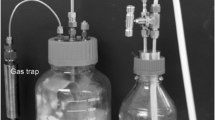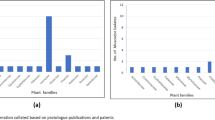Abstract
An endophytic fungus of Persea indica was identified, on the basis of its anamorphic stage, as Nodulosporium sp. by SEM. Partial sequence analysis of ITS rDNA revealed the identity of the teleomorphic stage of the fungus as Hypoxylon sp. It produces an impressive spectrum of volatile organic compounds (VOCs), most notably 1,8-cineole, 1-methyl-1,4-cyclohexadiene, and tentatively identified (+)-.alpha.-methylene-.alpha.-fenchocamphorone, among many others, most of which are unidentified. Six-day-old cultures of Hypoxylon sp. displayed maximal VOC-antimicrobial activity against Botrytis cinerea, Phytophthora cinnamomi, Cercospora beticola, and Sclerotinia sclerotiorum suggesting that the VOCs may play some role in the biology of the fungus and its survival in its host plant. Media containing starch- or sugar-related substrates best supported VOC production by the fungus. Direct on-line quantification of VOCs was measured by proton transfer mass spectrometry covering a continuous range with optimum VOC production occurred at 6 days at 145 ppmv with a rate of production of 7.65 ppmv/h. This report unequivocally demonstrates that 1,8-cineole (a monoterpene) is produced by a microorganism, which represents a novel and important source of this compound. This monoterpene is an octane derivative and has potential use as a fuel additive as do the other VOCs of this organism. Thus, fungal sourcing of this compound and other VOCs as produced by Hypoxylon sp. greatly expands their potential applications in medicine, industry, and energy production.







Similar content being viewed by others
References
Agency for Toxic Substances and Disease Registry (ATSDR) (2007) Toxicological profile for Benzene (Update). U.S. Department of Public Health and Human Services, Public Health Service, Atlanta
Azeez S (2008) In: Parthasarathy VA, Chempakam B, Zachariah T (eds) Fennel. In chemistry of spices. CAB International, Cambridge, pp 227–241
Bacon C, White J (2000) Microbial endophytes. Marcel Dekker, New York
BartonA KA (1997) High cineole eucalyptus oils in degreasing applications. Chem Aust 64:4–6
Barton A, Tjandra J (1989) Eucalyptus oil as a cosolvent in water-ethanol-gasoline mixtures. Fuel 68:11–17
Breton T, Liaigre D, Belgsir EM (2005) Aromatization of cyclohexadienes by TEMPO electro-mediated oxidation: kinetic and structural aspects. Electrochem Commun 7:1445–1448
Brooks BT (1922) In: Brooks BT (ed) The cyclic non-benzoid hydrocarbons: the cyclohexane series. In the chemistry of non-benzoid hydrocarbons and their simple derivatives. Chemical Catalog Company, Inc, New York, pp 278–383
Bull A (2004) Microbial diversity and bioprospecting. ASM Press, Washington DC
Bunge M, Araghipour N, Mikoviny T, Dunkl J, Schnitzhofer R, Hanzel A, Schinner F, Wisthaler A, Margesin R, Märk TD (2008) On-line monitoring of microbial volatile metabolites by proton transfer reaction-mass spectroscopy. Appl Environ Microbiol 74:2179–2186
Cook CM, Kokkini S, Lanaras T (2007) Mentha spicata essential oils rich in 1, 8.cineole and 1, 2-epoxy-P-methane derivates from Zakynthos (Ionian Island, W Greece). J Essent Oil Res 19:225–230
Cosimi S, Rossi E, Cioni P, Canale A (2009) Bioactivity and qualitative analysis of some essential oils from Mediterranean plants against stored-product pests: evaluation of repellency against Sitophilus zeamais Matschulsky, Cryptolestes ferrugineus (Stephens) and Tenebrio molitor (L.). J Stored Prod Res 45:125–132
Croteau R, Alonso WR, Koepp AE, Johnson MA (1994) Biosynthesis of monoterpenes: partial purification, characterization and mechanism of action of 1, 8-cineole synthase. Arch Biochem Biophys 309:184–192
Davis R (1979) Olfactory perceptual space models compared by quantitative methods. Chem Senses 4:21–33
Ezra D, Hess W, Strobel G (2004) Unique wild type endophytic isolates of Muscodor albus, a volatile antibiotic producing fungus. Microbiology 150:4023–4031
Ezra D, Jasper J, Rogers T, Knighton B, Grimsrud E, Strobel G (2004) Proton transfer reaction-mass spectroscopy as a technique to measure volatile emissions of Muscodor albus. Plant Sci 166:1471–1477
Furia T, Bellanca N (1971) Fenaroli’s handbook of flavor ingredients. Chemical Research Co, Cleveland
Hanlin RT (1997) Illustrated genera of ascomycetes. Am Phytopath Press, St Paul
Hepworth JD, Waring DR, Waring MJ (2002) In: Chemistry A (ed) Oxidation and reduction of aromatic compounds. In aromatic chemistry. Royal Society of Chemistry, Cambridge, UK, pp 129–134
Hong C, Shellock F (1991) Effects of a topically applied counterirritant (Eucalyptanin) on cutaneous blood flow and on skin and muscle temperatures. A placebo-controlled study. Am J Phys Med Rehabil 70:29–33
Kempler GM (1983) Production of Flavor Compounds by Microorganisms. III. Terpenenes. B. Production of Monoterpenes by Microorganisms. In: Laskin AI (ed) Advances in Applied Microbiology, vol 29. New York, Academic Press, pp 35–37
Leung Y (1980) Eucalyptus. Wiley, New York
Lindinger W, Hansel A, Jordan A (1998) On-line monitoring of volatile organic compounds at pptv levels by means of proton-transfer-reaction mass spectrometry (PTR-MS): medical applications, food control and environmental research. Int J Mass Spectrom Ion Process 173:191–241
Madyastha KM (1984) Microbial transformations of acyclic monoterpenes. J Chem Sci 93:677–686
Mittermeier RA, Meyers N, Gil P, Mittermeier C (1999) Hotspots: Earth’s biologically richest and most endangered ecoregions. Toppan Printing Co., Japan
Opdyke D (1975) Monographs on fragrance raw materials. Food Cosmet Toxicol 13:91–112
Pinkerton F, Strobel G (1976) Serinol as an activator of toxin production in attenuated cultures of Helminthosporium sacchari. Proc Natl Acad Sci USA 73:4007–4011
Robinson T (1983) The organic constituents of higher plants. Cordus Press, Amherst
Saitou N, Nei M (1987) The neighbor-joining method: a new method for reconstructing phylogenetic trees. Mol Biol Evol 4:406–425
Southwell I, Russell M, Smith RL, Brophy JJ, Day J (2003) Melaleuca teretifolia chemovars: New Australian sources of citral and 1, 8-cineole. J Essent Oil Res 15:339–341
Smith DC, Gray HB (1990) Catalysis of the oxidation of 1, 4-cyclohexadiene to Benzene by electroactive binuclear rhodium complexes. Catal Lett 6:195–200
Smith SA, Tank DC, Boulanger LA, Bascom-Slack CA, Eisenman K, Babbs B, Fenn K, Greene JS, Hann BD, Keehner J, Kelley-Swift EG, KembaiyanV LSJ, Li P, Light DY, Lin EH, Ma C, Moore E, Schorn MA, Vekhter D, Nunez PN, Strobel G, Donoghue MJ, Strobel SA (2008) Bioactive endophytes warrant intensified exploration and conservation. PloS One 3(8):e3052
Steen EJ, Kang Y, Bokinsky G, Hu Z, Schirmer A, McClure A, del Cardayre SB, Keasling JD (2010) Microbial production of fatty-acid-derived fuels and chemicals from plant biomass. Nature 463:559–562
Strobel GA, Daisy B (2003) Bioprospecting for microbial endophytes and their natural products. Microbiol Mol Biol Rev 67:491–502
Strobel GA, Dirksie E, Sears J, Markworth C (2001) Volatile antimicrobials from Muscodor albus, a novel endophytic fungus. Microbiology 147:2943–2950
Strobel GA, Knighton B, Kluck K, Ren Y, Livinghouse T, Griffi M, Spakowicz D, Sears J (2008) The production of myco-diesel hydrocarbons and their derivatives by the endophytic fungus Gliocladium roseum (NRRL 50072). Microbiology 154:3319–3328
Sugito K, Takeda S (1981) Patent No. 4,297,109. Japan.
Tamura K, Dudley J, Nei M, Kumar S (2007) MEGA4: molecular evolutionary genetics analysis (MEGA) software version 4.0. Mol Biol Evol 24:1596–1599
Tan R, Zou W (2001) Endophytes: a rich source of functional metabolites. Nat Prod Rep 18:448–459
Thomas J, Joy PP, Mathew S, Skaria BP (2000) Plant sources of aroma chemicals and medicines in India. Chemical Industry Digest (Special Millennium Issue). pp. 104–108.
Weyerstahl P, Marschall H, Scora RW (1993) Constituents of the leaf essential oil of Persea indica (L.) K. Spreng. Flavour Fragr J 8:201–207
Worapong J, Strobel G, Ford E, Li J, Baird G, Hess W (2001) Muscodor albus anam. nov., an endophyte from Cinnamomun zeylanicum. Mycotaxon 79:67–79
Zentmyer GA, Campbell SD, Guillemet FB (1990) Persea indica. California Avocado Society 1990 Yearbook 74: 239–242.
Acknowledgments
The author’s acknowledge the financial support of the National Science Foundation and DoE grants CBET-0802666 to GAS and NSF grant EFRI-0937613 to Brent Peyton at MSU. Also support was provided by an NSSEFF grant from the Department of Defense to Scott Strobel at Yale University. It is noted that D.E., O.L., and D.E. were responsible for the molecular genetics reported in this work.
Author information
Authors and Affiliations
Corresponding author
Rights and permissions
About this article
Cite this article
Tomsheck, A.R., Strobel, G.A., Booth, E. et al. Hypoxylon sp., an Endophyte of Persea indica, Producing 1,8-Cineole and Other Bioactive Volatiles with Fuel Potential. Microb Ecol 60, 903–914 (2010). https://doi.org/10.1007/s00248-010-9759-6
Received:
Accepted:
Published:
Issue Date:
DOI: https://doi.org/10.1007/s00248-010-9759-6




